Japanese Kitchen Cabinets: Wafu-Inspired Styles & Modern Harmony
- What Is "Wafu" Kitchen Cabinetry?
- The Aesthetic Benefits of Japanese-Style Cabinets
- Comfort and Quality of Life
- 6 Key Features of Wafu-Style Kitchen Cabinets
- How to Style a Wafu Kitchen Cabinet in a Modern Home
- Japandi Kitchen Cabinets for a Softer Modern Look
- No Renovation? Add a Wafu Cupboard Instead
- Caring for Your Japanese Kitchen Cabinets: Maintenance Tips
- Bringing Japanese Kitchen Cabinets into Your Home
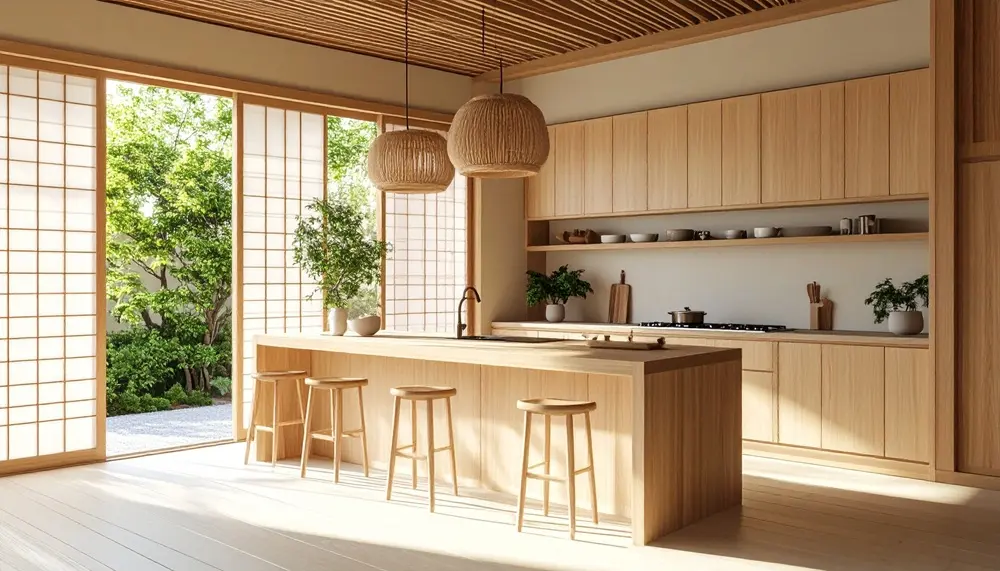
Coupled with the global boom in Zen and minimalism, Japanese interior design has gained a dedicated following far beyond Japan's borders. Even within Japan, modern interpretations of traditional interiors are becoming increasingly popular across all generations, appreciated for their stylish, understated appeal.
When creating a Japanese-style home, it can feel straightforward to bring the look into a living room or bedroom by using fabrics, art, or decorative accents. The kitchen, however, can be more challenging. Japanese-style kitchens are not only a place for preparing meals but also a space where craftsmanship, simplicity, and nature converge.
This philosophy is expressed through wafu (和風), a Japanese word that simply means "Japanese style." You may have come across it on menus, such as wafu pasta or wafu dressing, indicating a Japanese twist on familiar dishes. In interior design, wafu carries a similar meaning: design that makes use of natural materials and simple textures, and finds beauty in imperfections, white space and minimal ornamentation. Rooted in wabi-sabi, it values simplicity, irregularity, and even the changes that occur over time as wood darkens or fabrics soften with use. In kitchens, wafu cabinetry unites function and beauty through natural materials, subtle curves, and handcrafted details, creating spaces that feel warm, expressive, and connected to daily life.
In this article, we will cover the key features of Wafu kitchen cabinetry, styling tips for modern homes, how to blend Japanese and Scandinavian designs with Japandi cabinets, simple ways to add Japanese charm without renovation, and care tips to keep your cabinets lasting beautifully.
What Is "Wafu" Kitchen Cabinetry?
If you want to create a Japanese-style kitchen, the cabinetry is the natural starting point. Cabinets occupy a large portion of the kitchen's surface area, making them the most visible and influential element in setting the overall tone of the space. Wafu kitchen cabinetry refers to designs that incorporate the defining elements of traditional Japanese aesthetics while adapting to contemporary needs. Hallmarks include the use of natural woods like cedar and cypress, colors and textures drawn from nature, and architectural features such as lattice doors, sliding panels, and shoji-inspired screens. The craftsmanship emphasizes proportion, balance, and visual lightness, ensuring the kitchen feels open and harmonious. In modern homes, these elements can be blended with streamlined layouts and updated finishes, making the design versatile enough to suit both classic and contemporary spaces.
The Aesthetic Benefits of Japanese-Style Cabinets
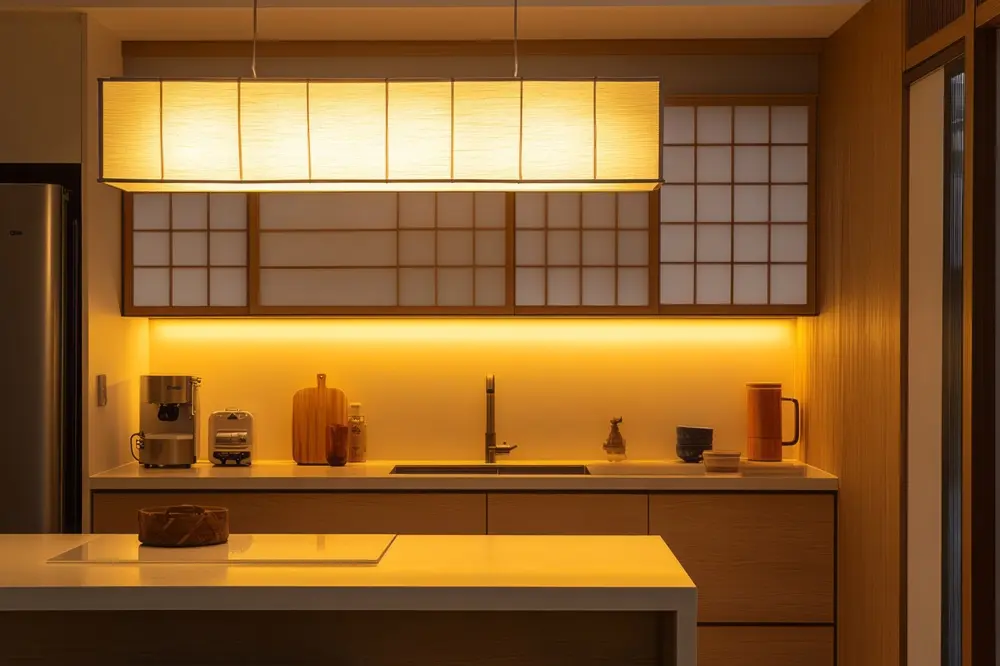
Wafu kitchen cabinetry is more than just a storage solution, it is a statement of harmony, beauty, and thoughtful living. Solid woods such as cedar and cypress bring a distinctive warmth, with their grain and natural tones lending character to the space. Over the years, these materials develop a richer patina, their beauty deepening in tandem with the life of the home.
Colors and textures in Japanese-style cabinets are drawn from nature, often featuring plain wood finishes, muted earth tones, ink reds, and deep greens, and even soft white woods. The matte surfaces with a gentle sheen convey an understated elegance while avoiding glare or visual harshness. Traditional design elements, such as lattice doors, sliding panels, and shoji-style screens, infuse the space with authentic Japanese charm. Even the hardware is thoughtfully considered, with handles and fittings that add beauty in subtle, tactile ways.
These cabinets excel at harmonizing with their surroundings. In a traditional setting, they blend seamlessly with tatami mats, wooden beams, and natural textures, enhancing the overall rhythm of the home. In modern interiors, they act as a refined Japanese accent, offering a touch of heritage that complements contemporary minimalism. Their visual lightness is another key feature, sliding doors and lattice designs maintain a sense of openness, allowing glimpses through the panels and creating the perception of more space. This approach keeps even compact kitchens feeling airy and uncluttered.
Comfort and Quality of Life
Beyond their visual appeal, Wafu cabinetry is designed to enhance everyday living. Natural wood surfaces are warm and pleasant to the touch, while sliding doors operate smoothly without encroaching on walkways. The proportions and layout are carefully considered to reduce clutter and make cooking a more fluid, enjoyable experience. By merging beauty with ergonomics, Japanese-style kitchen cabinets create an environment that is calming, functional, and deeply satisfying to use.
6 Key Features of Wafu-Style Kitchen Cabinets
Understanding the essential characteristics of Wafu-style kitchen cabinets helps you bring authentic Japanese aesthetics into your home. These key features—from material choices to finishes and hardware, work together to create a kitchen that embodies natural beauty, simplicity, and harmony. Exploring each element in detail will guide you in selecting and styling cabinetry that captures the true spirit of Japanese design.
1. Natural Materials
The foundation of authentic Wafu-style kitchen cabinets lies in their materials. Solid woods such as cedar, cypress, and oak bring warmth through their natural grain and tone, while bamboo offers a lighter, more delicate texture. A lacquer finish can add a subtle depth while also enhancing durability and offering natural antibacterial properties—qualities that have made lacquerware prized in Japanese daily life for centuries. For an especially rich and lived-in look, aged cedar, dark walnut, or knotty oak evoke the timeworn beauty of wabi-sabi, adding tactile charm and visual warmth.
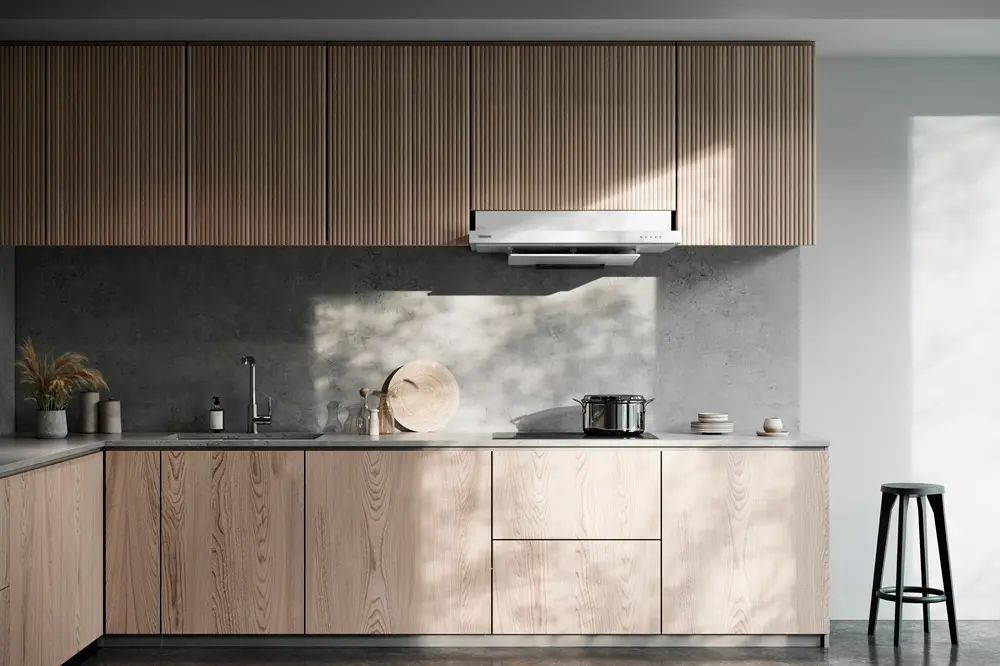
2. Matte & Rough Finishes
Rather than glossy, high-shine surfaces, Wafu kitchen cabinets embrace finishes that feel authentic and hand-touched. Hand-brushed wood, charred timber (shou sugi ban), or lightly unpolished textures lend character and history to the space. These finishes not only look beautiful but also invite a more tactile connection to the kitchen.
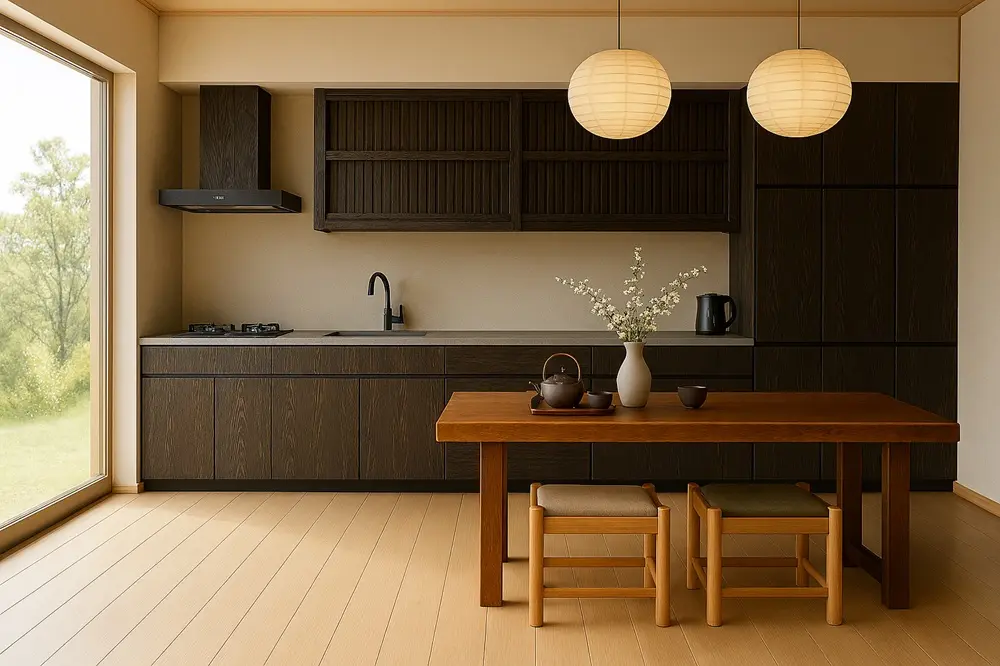
3. Muted Earth Tones
A harmonious color palette is essential to Japanese kitchen design. Deep greens, charcoal blacks, sand beiges, and soft white woods work together to create a calm, grounded atmosphere. White oak, ash, or light birch can introduce brightness without breaking the overall serenity, especially when paired with warmer undertones. Rather than relying on bold or highly saturated colors, Wafu kitchens favor muted tones that echo natural landscapes, helping the space feel cohesive and restful.
While Japandi interiors often emphasize pale woods and light, airy palettes, Japanese style tends to incorporate heavier colors. Subdued greens, ink-like blacks, and dark wood tones are especially characteristic, directly linking the kitchen's atmosphere to the depth and grounding presence found in traditional Japanese interiors.
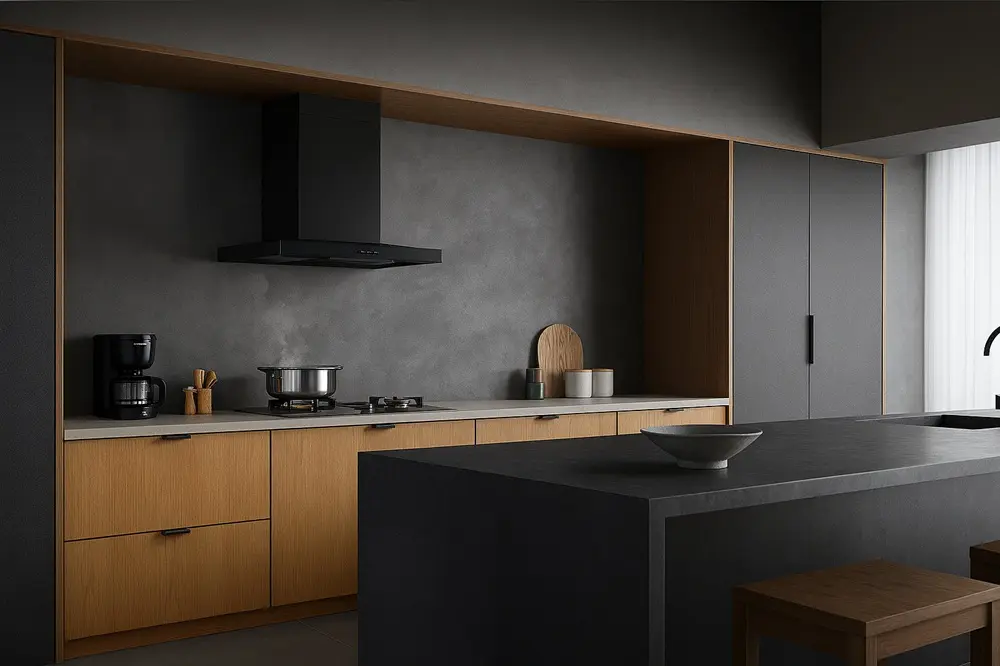
4. Shoji and Lattice Motifs
Architectural details such as shoji screens, wooden slats, and grille patterns add softness and rhythm to cabinetry. Translucent panels filter light and create a sense of depth without adding heaviness, while latticework introduces a subtle, textural elegance that recalls traditional Japanese interiors. Among these, the kumiko pattern stands out, an intricate, handcrafted lattice technique often used in shoji and cabinetry. Beyond its refined beauty, kumiko designs are imbued with auspicious meanings, with motifs symbolizing longevity, harmony, or protection, making them both decorative and culturally meaningful.
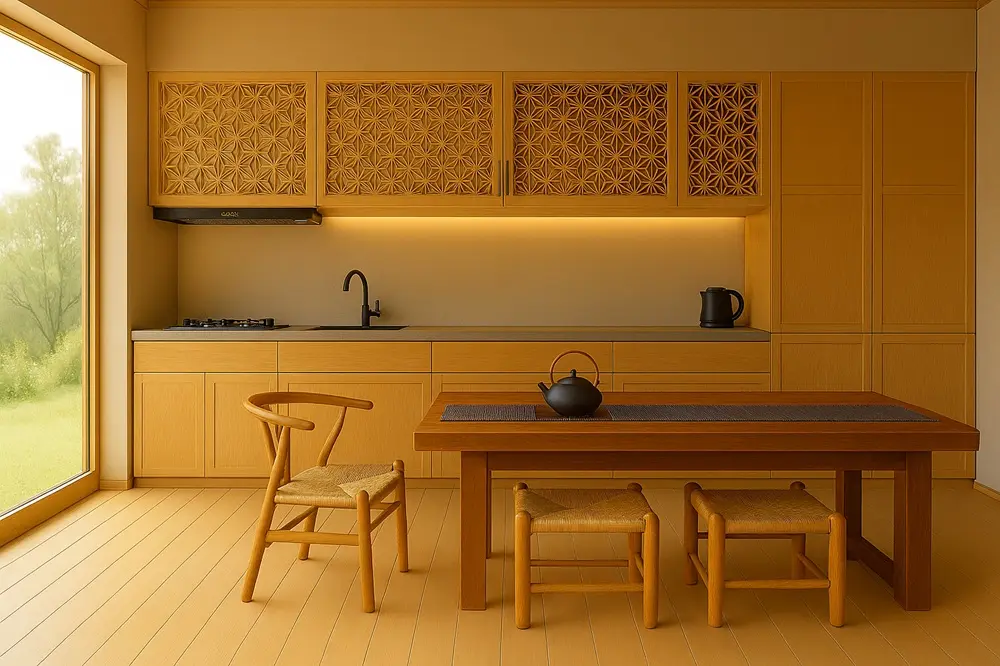
5. Minimalist Hardware or Hidden Handles
In keeping with the philosophy of letting materials speak for themselves, hardware is often kept minimal, subtly present, or even hidden entirely. Handles that blend with the cabinet, or those with a quiet, understated presence, help maintain the focus on the grain, texture, and form of the wood. For simpler cabinets, a slightly decorative handle can be introduced to add a refined touch without overwhelming the design.
Handles are typically made from natural materials such as brass, iron, ceramic, or wood, often with a handmade feel. Metal handles usually feature a matte finish with a subdued sheen, in colors like black, antique gold, or burnished brown. Elegant detailing, such as gentle curves, carved patterns, or textured surfaces, adds visual interest while remaining harmonious with the overall design. Recessed or integrated handles, built into grooves or channels, create a handle-free appearance that reinforces the sense of simplicity and lightness.
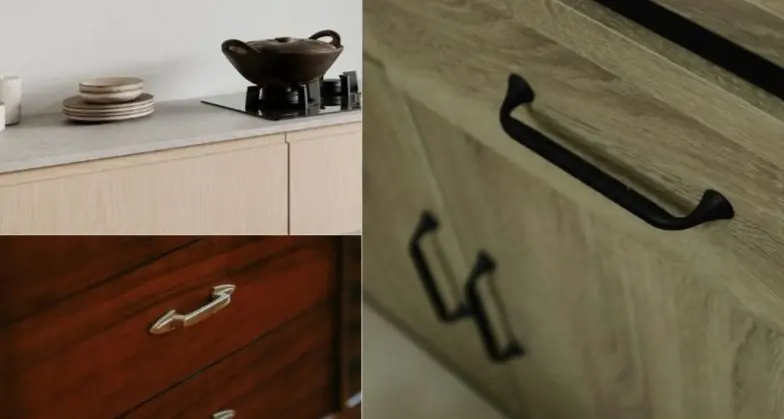
6. Low-Profile Design and a Sense of Openness
A defining feature of Wafu kitchen cabinetry is its emphasis on a low-profile design that fosters a sense of openness and lightness. Rather than filling the space with towering upper cabinets, Wafu kitchens often keep cabinetry close to the floor, making use of the area beneath counters to maximize storage while maintaining clean sightlines. This approach allows natural light to flow freely, creating a sense of spaciousness and reinforcing the harmonious, uncluttered atmosphere characteristic of Japanese interiors. Sliding doors, modular elements, and thoughtfully arranged storage maintain functionality without crowding the space, creating a kitchen that feels calm, balanced, and deeply connected to daily life. By prioritizing openness and simplicity, Wafu cabinetry embodies the understated beauty and serenity that define traditional Japanese design.
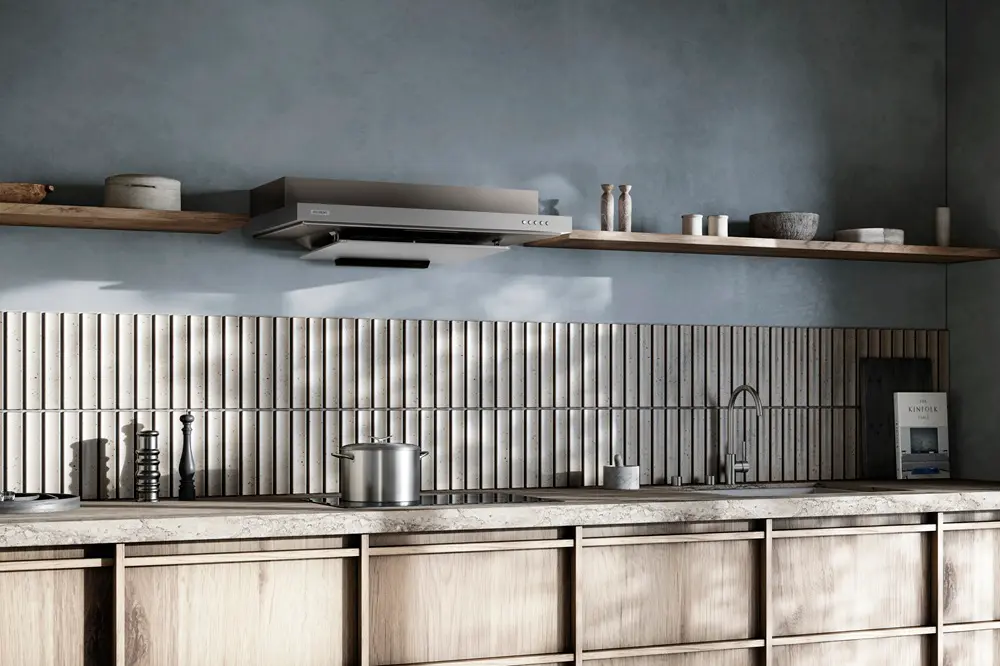
How to Style a Wafu Kitchen Cabinet in a Modern Home
Styling Wafu kitchen cabinets within a modern home offers an exciting opportunity to blend tradition with contemporary living. The key is to balance the warm, natural elements of Japanese design with the clean lines and technology of today's kitchens. Thoughtful integration creates spaces that feel both timeless and fresh, allowing the beauty of Wafu cabinetry to shine alongside modern conveniences.

1. Integrate with Contemporary Appliances
Pairing Wafu-style kitchen cabinets with sleek, modern appliances creates a striking balance between old and new. A traditional wooden cabinet set can be contrasted with a streamlined induction stovetop, minimalist steel countertops, or built-in ovens, allowing both styles to enhance each other. Matte-finished appliances work especially well, blending seamlessly with the natural tones of the cabinetry. Colors such as white, gray, and black complement the wood's warmth while maintaining the calm, understated aesthetic central to Wafu design.
2. Use Lighting to Highlight Texture
Lighting plays a crucial role in showcasing the depth and texture of Japanese kitchen cabinets. Warm, indirect lighting such as under-cabinet strips or pendant lamps, casts gentle shadows that emphasize wood grain, deep colors, and crafted details, creating an inviting atmosphere.
3. Keep Decor Minimal, Meaningful
In Wafu interiors, every item has a purpose and a place. Avoid cluttered countertops or excessive ornamentation, and instead select one or two statement pieces that embody the beauty of utility. Focus on objects used in cooking or at the dining table, such as a small hand-thrown bowl, a tea set, or an earthenware cooking pot. Tenugui towels, traditional Japanese cotton cloths, can be used as kitchen towels, they add a touch of color and pattern while remaining practical and easy to display.
Japandi Kitchen Cabinets for a Softer Modern Look
For those who love the serenity of Japanese design but prefer a lighter, more Scandinavian feel, Japandi kitchen cabinets offer the perfect middle ground. This hybrid style blends the calm simplicity of Wafu with the practicality of Scandinavian interiors. Pale woods such as white oak, ash, or light birch bring an airy brightness, while still maintaining the organic warmth central to Japanese aesthetics.
Clean geometric lines, soft tactile textures, and a restrained color palette create a space that feels open and welcoming. The use of white wood in particular acts as a visual link, light enough to evoke Nordic minimalism, yet warm and natural enough to harmonize with traditional Japanese elements like shoji screens, bamboo baskets, or earthenware pots. The result is a kitchen that feels fresh, bright, and contemporary, while preserving a grounding connection to nature.
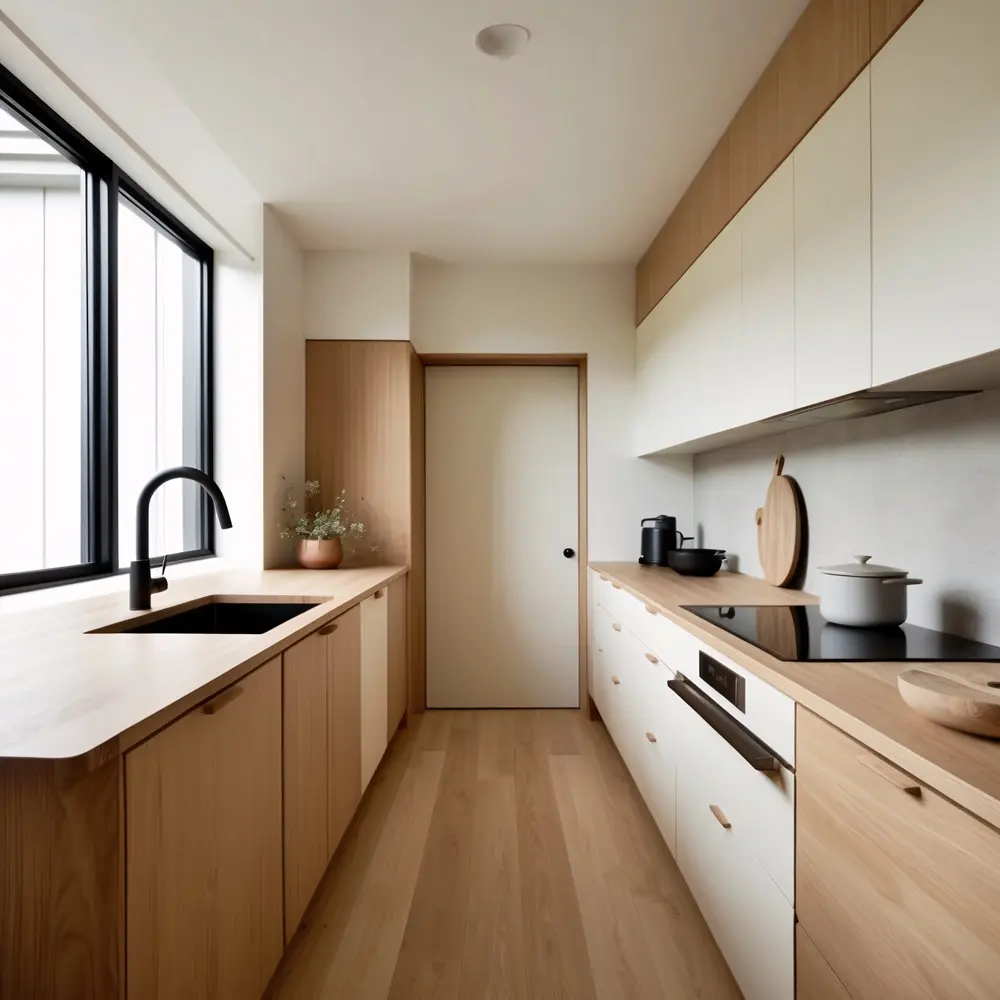
No Renovation? Add a Wafu Cupboard Instead
If built-in Japanese kitchen cabinets are not an option, a freestanding Wafu cupboard can still bring authentic charm to your space. Two-tier dish cabinets with sliding wooden or glass doors work beautifully for storing pottery, dishware, or table linens. They are ideal for renters or small homes, offering an instant upgrade without structural changes. For those searching for a "Japanese style cupboard," this is a versatile and space-efficient solution that can transform your kitchen's atmosphere overnight.
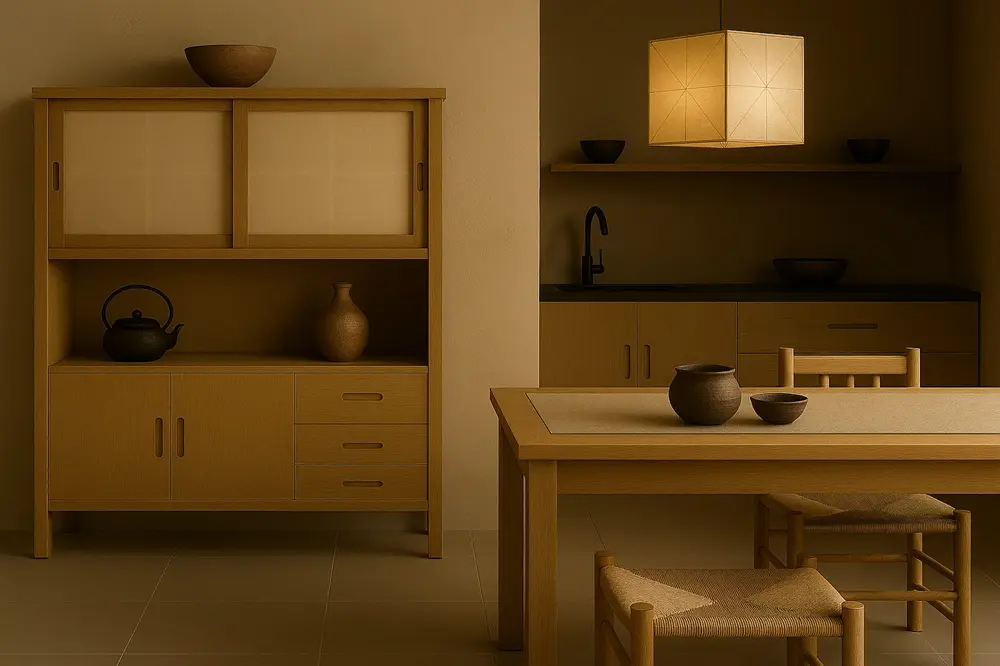
Caring for Your Japanese Kitchen Cabinets: Maintenance Tips
To keep your Wafu-style kitchen cabinets looking their best, regular care is essential, especially when using natural materials like white wood, cedar, or cypress. Clean surfaces gently with a soft, damp cloth and avoid harsh chemicals or abrasive cleaners that can damage the wood's finish. For lacquered or matte finishes, using mild, natural soaps diluted in water helps preserve the subtle sheen without stripping protective layers.
Because natural wood can be sensitive to moisture and temperature changes, maintaining stable indoor humidity levels will prevent warping or cracking. Applying a natural wood oil or wax occasionally can also nourish the wood, enhancing its patina and prolonging its lifespan. With attentive care, your Japanese kitchen cabinets will age gracefully, deepening their beauty and maintaining their warmth for years to come.
Bringing Japanese Kitchen Cabinets into Your Home
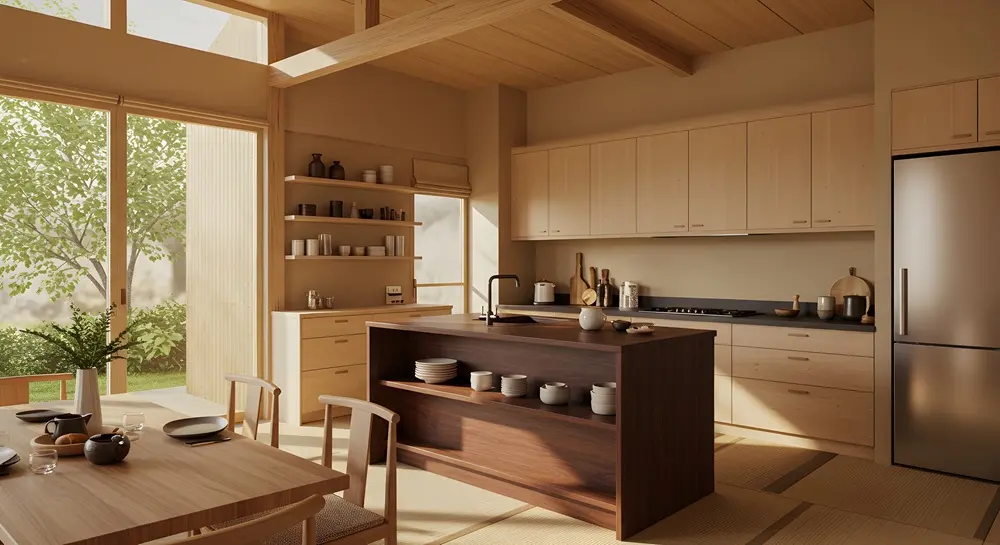
Japanese kitchen cabinets represent more than just storage, they embody a philosophy of harmony, craftsmanship, and connection to nature. Whether you choose a full built-in Wafu cabinet system, a Japandi-inspired hybrid, or a simple freestanding cupboard, these designs bring warmth and tranquility to the heart of the home. By focusing on natural materials, muted tones, and thoughtful details, you can create a kitchen that feels both timeless and deeply personal, enriching your daily life with every use.
*Some of the images featured in this article were created using generative AI.

